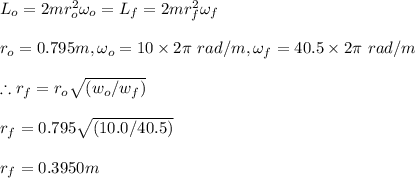
A professor sits on a rotating stool that is spinning at 10.0 rpm while she holds a heavy weight in each of her hands. Her outstretched hands are 0.795 m from the axis of rotation, which passes through her head into the center of the stool. When she symmetrically pulls the weights in closer to her body, her angular speed increases to 40.5 rpm. Neglecting the mass of the professor, how far are the weights from the rotational axis after she pulls her arms in

Answers: 1


Other questions on the subject: Physics

Physics, 21.06.2019 18:10, HOTaco554
After the near spacecraft passed mathilde, on several occasions rocket propellant was expelled to adjust the spacecraft's momentum in order to follow a path that would approach the asteroid eros, the final destination for the mission. after getting close to eros, further small adjustments made the momentum just right to give a circular orbit of radius 45 km (45 × 10^3 m) around the asteroid. so much propellant had been used that the final mass of the spacecraft while in circular orbit around eros was only 545 kg. the spacecraft took 1.04 days to make one complete circular orbit around eros. calculate what the mass of eros must be.
Answers: 1

Physics, 22.06.2019 01:30, bvolleyball9
Afigure skater is rotating at a rate of 200 revolutions per minute. what is the angular speed, in units of rad/s? 20.9 12000 200 3.33
Answers: 2

Physics, 22.06.2019 04:40, joneil1952
Argon is adiabatically compressed from an initial volume of 16 liters to a final volume of 2 liters. by what factor do the following quantities change? do they increase or decrease? (a) the rms speed (b) the thermal energy of the gas (c) the molar specific heat cv (d) the pressure
Answers: 3

Physics, 22.06.2019 07:30, anonymous1813
Some material consisting of a collection of microscopic objects is kept at a high temperature. a photon detector capable of detecting photon energies from infrared through ultraviolet observes photons emitted with energies of 0.3 ev, 0.5 ev, 0.8 ev, 2.0ev, 2.5ev, and 2.8ev. these are the only photon energies observed. (a) draw and label a possible energy-level diagram for one of the microscopic objects, which has four bound states. on the diagram, indicate the transitions corresponding to the emitted photons. explain briefly. (b) would a spring–mass model be a good model for these microscopic objects? why or why not? (c) the material is now cooled down to a very low temperature, and the photon detector stops detecting photon emissions. next, a beam of light with a continuous range of energies from infrared through ultraviolet shines on the material, and the photon detector observes the beam of light after it passes through the material. what photon energies in this beam of light are observed to be significantly reduced in intensity (“dark absorption lines”)? explain briefly.
Answers: 3
You know the right answer?
A professor sits on a rotating stool that is spinning at 10.0 rpm while she holds a heavy weight in...
Questions in other subjects:


Mathematics, 25.02.2021 05:40



Mathematics, 25.02.2021 05:40

Mathematics, 25.02.2021 05:40

Geography, 25.02.2021 05:40



 and that the two masses have the same radius:
and that the two masses have the same radius:



